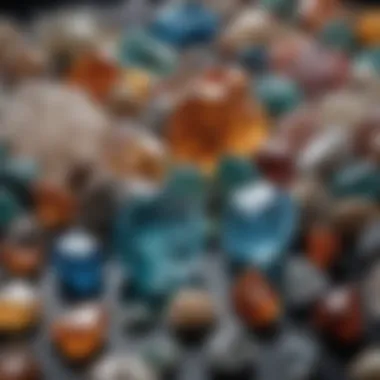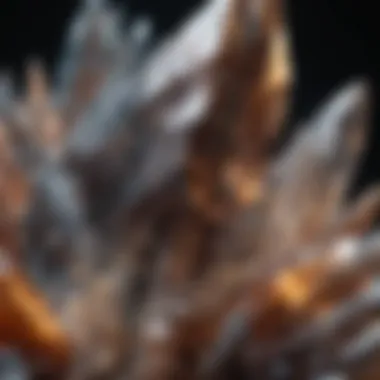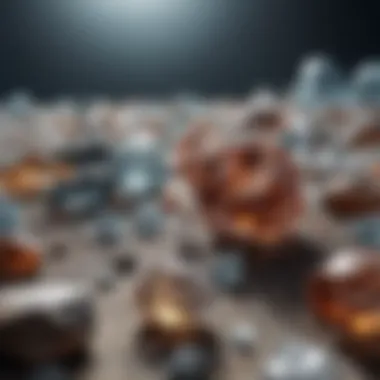The Economics of Crystals: Cost Influencers Unveiled


Intro
The analysis of crystal costs is a journey that intertwines natural beauty with economic principles. Many enthusiasts typically view crystals as objects of art or collectors’ items. However, the factors influencing the price of these specimens extend far deeper than their aesthetic appeal. Understanding these dynamics is essential for making informed choices in the market.
The crystal market encompasses vast varieties, ranging from quartz to more precious stones like diamonds and sapphires. Prices fluctuate based on numerous variables, including material quality, rarity, and current market demands.
This article aims to dissect these key elements, empowering collectors with the knowledge to navigate the complexities involved in appreciating and purchasing crystal specimens.
Featured Collectible of the Month
Overview
This month, we highlight the Rose Quartz, praised for its delicate pink hue and calming properties. Known as the stone of love, Rose Quartz is not only visually stunning but also steeped in rich traditions and beliefs. Its popularity has surged in recent years, particularly among collectors driven by trends in wellness and self-care.
Historical Significance
Rose Quartz has been utilized throughout history, dating back to ancient civilizations. Egyptians crafted jewelry from this stone, believing it to promote beauty and love. The Greeks also valued it, associating its colors with the goddess of love, Aphrodite. As such, the historical context significantly contributes to its market relevance today.
Pricing Dynamics
When evaluating crystal costs, several core factors demand attention:
- Material Quality: The purity and clarity of the crystal heavily influence its price. Higher-quality specimens, void of inclusions, fetch premium prices.
- Rarity: Some crystals are rare due to limited geographical occurrences. For instance, certain types of beryl are not commonly found, impacting their market value.
- Market Trends: Trends can powerfully shift the demand. For example, social media influences many collectors, with sudden spikes in popularity affecting prices dramatically.
Understanding these elements equips both new and seasoned collectors with the insights necessary for smarter investment.
Identification Techniques
Visual Characteristics
Identifying crystals can be straightforward with the right knowledge. Key characteristics include:
- Color: The intensity of color can indicate quality. Brighter hues often correlate with higher values.
- Transparency: Clear specimens typically hold more value than their opaque counterparts.
- Shape and Size: Larger crystals or those with unique formations often command higher prices.
Resources for Identification
Enthusiasts can consult various resources to improve their identification skills. Some helpful materials include:
- Gemological Institute of America (GIA): They offer detailed guides on identifying gemstones and crystals.
- The Mineralogical Record: This publication provides in-depth articles on specific minerals, helping collectors learn more.
- Online forums like Reddit and Facebook groups can also be insightful places for sharing knowledge and experiences.
"Knowledge and expertise in crystal identification are paramount to excelling in this luxury market."
As the crystal market continues to evolve, staying abreast of changes becomes crucial for collectors—merging economic understanding with practical identification skills can lead to more satisfying purchasing outcomes.
Understanding the Basics of Crystal Pricing
Understanding the pricing of crystals is essential for collectors and enthusiasts. Crystal prices are not merely based on their aesthetic qualities. Instead, a variety of factors contribute to their valuation. By grasping these foundational elements, one can make informed decisions and potentially enhance their collections.
When considering crystal pricing, the raw materials, the craftsmanship involved, and the market dynamics play a crucial role. Each aspect holds significance and can determine the value of a crystal piece. Moreover, it is vital to recognize that crystal prices can vary widely, depending on the factors at play. This variance underscores the importance of familiarizing oneself with the basics of crystal pricing before making any purchase.
What Affects Crystal Prices
Multiple elements influence the prices of crystals. Rarity is among the most significant factors. Some crystals are naturally rare due to their unique formation conditions or limited geographic occurrence. For example, diamonds are considerably rarer than quartz, which is readily available. The quality of crystals also plays a vital role in their pricing. High-quality crystals that possess exceptional clarity and color tend to command higher prices.
Another factor is market demand. When specific crystals are in high demand, their prices can escalate dramatically. Shifts in trends, influenced by fashion or collector interest, can also affect willingness to pay. For instance, if a certain healing crystal becomes popular among wellness communities, prices may rise due to increased attention.


Price fluctuations can occur due to geopolitical influences affecting supply. Political unrest in key extraction regions or changes in trade regulations can lead to sudden shifts in availability and therefore pricing.
Types of Crystals and General Price Ranges
Crystal types present varied price ranges, which can reflect their unique attributes. For instance, common crystals like amethyst or citrine can range from $5 to $50 per piece in simpler forms. In contrast, more exotic options, such as moldavite or tanzanite, can start at $100 and escalate dramatically based on quality and size.
Here’s a brief overview of some common types of crystals and their indicative price ranges:
- Quartz: $5 - $50
- Amethyst: $10 - $100
- Citrine: $20 - $150
- Rose Quartz: $10 - $80
- Tanzanite: $100 - $1,000 and up
- Moldavite: $50 - $500 and up
These general ranges help to outline how various factors contribute to the overall value of crystals. Collectors need to understand these price points to navigate their purchases wisely.
"An understanding of the fundamental pricing factors can lead to better collecting experiences and increased satisfaction in one's hobb.y"
As collectors delve deeper into the world of crystal pricing, this foundational knowledge equips them to appreciate and value their pieces with clarity.
Market Dynamics in the Crystal Industry
Understanding market dynamics is crucial for anyone involved in the crystal industry. The interplay between supply and demand, along with various economic influences, determines pricing in this unique market. Recognizing these factors allows collectors, retailers, and enthusiasts to navigate the complexities of crystal trading with greater insight.
Supply and Demand Factors
The basic economic principle of supply and demand plays a pivotal role in determining crystal prices. When demand for a specific type of crystal increases, the prices generally rise, provided that the supply does not keep pace with that demand. Conversely, if there is an excess of a certain type of crystal and not enough collectors to purchase it, prices tend to drop.
Several factors impact supply and demand in the crystal industry:
- Consumer Interest: Trends can shift rapidly. For instance, during periods of heightened interest in healing crystals, demand spikes significantly.
- Rarity: Unique and rare crystals naturally attract higher prices due to their limited availability.
- Cultural Influences: Cultural beliefs around certain crystals can also drive demand. For example, crystals associated with spiritual benefits may see fluctuating demand based on societal interest in wellness.
The balance between supply and demand is not static. It can shift frequently, requiring individuals involved in the market to stay informed about current trends and consumer preferences.
Economic Influences on Pricing
The economic landscape heavily influences crystal pricing. Understanding these influences can provide valuable context for any crystal collector or trader.
Factors to consider include:
- Global Economic Conditions: Economic downturns can reduce discretionary spending, affecting collector interest and pricing. During booms, spending on luxury items, including crystals, tends to rise.
- Currency Fluctuations: Crystals are often imported from various countries. Changes in exchange rates can affect the final retail price. A stronger currency can make purchasing overseas crystals more affordable.
- Market Speculation: Like any other collectible market, speculation plays a role. When collectors anticipate significant increases in value, they may drive prices up, regardless of the actual worth of the item.
- Inflation Rates: Over time, inflation influences prices across all consumer goods, including crystals. As the cost of raw materials increases, so too does the pricing of finished products.
Staying abreast of these economic influences can better prepare collectors for price fluctuations and help them make informed purchasing decisions.
"Understanding the economics of the crystal market means knowing that prices are influenced as much by sentiment and trends as by tangible qualities of the stones themselves."
Engaging with market dynamics is essential for any serious enthusiast or collector. By comprehensively assessing both supply-demand interactions and economic contexts, one can effectively navigate the intricate world of crystal collecting.
Types of Crystals and their Cost Implications
Understanding the various types of crystals and their associated costs is essential for collectors and enthusiasts alike. Crystals are categorized based on factors such as rarity, usage, geographic origin, and availability. Each type carries its unique characteristics and resonates differently with the market. The implications of these costs are multifaceted, affecting both personal collection choices and broader market dynamics.
Common Crystals and Their Price Points
Common crystals, such as quartz, amethyst, and citrine, are generally more affordable. These crystals are often found in significant quantities worldwide, leading to a stable price frame. For example, quartz can range from $5 to $50 per piece, depending on purity, size, and aesthetic appeal. Amethyst, a popular member of the quartz family, usually sees prices between $10 and $100.
Factors Affecting Prices:
- Quality: Higher-quality specimens with minimal inclusions or clear transparency command higher prices.
- Size: Larger crystals often attract more interest and thus have increased value.
- Market Demand: Popularity due to trends can increase the prices of even common crystals substantially.
Rare and Expensive Crystals
In stark contrast, rare crystals can fetch exorbitant prices, sometimes reaching thousands of dollar. Examples include tanzanite, painite, and red beryl. The rarity of these stones is the primary driving force behind their high cost. Painite, for instance, was once considered the rarest mineral on Earth with price points reaching upwards of $60,000.


Key Considerations:
- Rarity and Availability: Limited supply directly correlates to higher demand and costs.
- Collector Interest: Rare crystals often attract serious collectors willing to pay premium prices for unique specimens.
- Cultural Significance: Some crystals hold historical or cultural weight, adding to their desirability and price.
Synthetic vs. Natural Crystals
The choice between synthetic and natural crystals represents a significant factor in pricing. Natural crystals are formed through geological processes, while synthetic crystals are artificially produced in labs to mimic natural counterparts.
Natural crystals often command higher prices due to their unique formation and perceived value. For instance, a natural diamond can cost significantly more than a synthetic one, often due to the emotional and historical context surrounding its formation.
Comparative Analysis:
- Cost: Synthetic crystals are usually cheaper. Lab-grown diamonds, for example, can be 20-40% less expensive than their natural counterparts.
- Perception: Many collectors prefer natural crystals for their authenticity.
- Ethical Considerations: Synthetic options are sometimes viewed as a more ethical choice, leading to nuanced discussions among buyers.
Understanding these segments allows collectors to refine their approaches, balancing desires for unique finds with practical financial implications.
The Role of Origin and Sourcing
Origin and sourcing play crucial roles in determining the pricing of crystal specimens. Each crystal has a unique story tied to its geographic origin, which can greatly influence its value. Understanding these factors is essential for collectors and enthusiasts alike, as they navigate the complexities of crystal economics. The location where a crystal is mined or cultivated not only affects its market availability but also impacts perceived quality and desirability. Certain regions are known for producing high-quality specimens, such as Madagascar for quartz and Brazil for amethyst, which further drives up their prices.
Geographic Factors in Pricing
Geographic factors are often foundational in crystal pricing. The distance from the source to the market, along with regional economic conditions, plays a role in the final cost. For instance, crystals sourced from remote or less accessible locations often entail higher shipping and handling costs.
Additionally, the reputation of the origin area can enhance the perceived value of a crystal. Collectors are more willing to pay a premium for specimens from reputable regions known for consistent quality, such as the Himalayas for certain quartz types. Factors such as local labor costs, mining regulations, and environmental practices can further influence pricing, either positively or negatively. Thus, understanding the geographic context can provide collectors a strategic advantage in their purchasing decisions.
Ethical Sourcing and Its Impact on Cost
Ethical sourcing is increasingly becoming a significant consideration in crystal economics. Many consumers today are prioritizing sustainability and responsible extraction practices. Crystals sourced from mines that adhere to ethical standards may come with a higher price tag due to fair labor practices and environmentally sound operations.
Ethical sourcing not only influences the cost but also affects market demand. Consumers are often willing to support brands and retailers who are transparent about their sourcing methods. For collectors, knowing the origin and the ethical considerations associated with a crystal can enhance its value, both personally and financially. As the market evolves, the emphasis on ethical sourcing is likely to have a lasting impact on pricing strategies within the crystal industry.
"Understanding the source of your crystals can significantly affect both their value and your purchasing decisions."
In summary, both geographic factors and ethical sourcing are interwoven with the economics of crystals. As collectors become more informed and conscientious, these elements will likely shape the future dynamics of crystal pricing.
Retail Strategies and Crystal Pricing
The interplay between retail strategies and crystal pricing is a significant aspect that influences collectors and their buying behaviors. Understanding how retailers approach pricing can guide collectors in making informed decisions. In this section, we will explore the various strategies retailers adopt, how they impact prices, and the overall value perceived in the market.
Pricing Strategies Used by Retailers
Retailers often employ diverse pricing strategies that directly impact the final cost of crystals to consumers. These strategies include:
- Cost-Plus Pricing: This common approach involves retailers calculating the cost of obtaining a crystal and adding a markup. The markup can vary based on the perceived value and rarity of the item.
- Competitive Pricing: Retailers monitor their competitors and adjust their prices accordingly. This often leads to more competitive market conditions, affecting overall pricing trends in the crystal industry.
- Psychological Pricing: Retailers sometimes price items at .99 or other figures to create a perception of savings. This strategy plays on buyer psychology and can persuade customers to make a purchase.
- Promotional Pricing: Temporary discounts or sales events can draw attention to particular crystals, increasing consumer interest and sales volume. While this may lower prices occasionally, it can encourage buyer urgency.
By adopting a clear pricing strategy, retailers can position their products effectively in the marketplace, fostering an understanding of the value of their offerings. This becomes essential as collectors seek to make educated purchases.
Online Marketplaces and Pricing Variability
The rise of online marketplaces such as eBay, Etsy, and others has introduced significant variability in crystal pricing. These platforms allow collectors to buy and sell a wide array of crystal specimens, leading to a diverse pricing landscape. Several factors contribute to this variability:
- Global Reach: Online marketplaces connect buyers and sellers from around the world. This opens the market to supplies from various geographical regions, which can have a notable impact on pricing.
- Auction Formats: In many online marketplaces, crystals are sold via auction. This can lead to competitive bidding, which may elevate prices unexpectedly.
- Seller Reputation: Prices can fluctuate based on the reputation of the seller. Established sellers with positive feedback can command higher prices for their specimens due to perceived trustworthiness and quality assurance.
"The internet has drastically altered how crystals are bought and sold, introducing unpredictability in pricing but also increasing accessibility for collectors."


- Market Demand: Trends within online communities also affect crystal pricing. Popular crystals may see a surge in prices based on current trends in decorating, healing, or collecting.
Collector Considerations
Understanding the intricacies of crystal economics is especially valuable for collectors. In the world of crystal collecting, value is more than just a number. It encompasses personal attachment, rarity, quality, and future potential. Collectors must navigate various factors to determine the real worth of their pieces. This section will consider these dynamics, shedding light on how to approach personal collections and market trends alike.
Determining Value for Personal Collections
The value of crystals for collectors is often subjective. Factors such as aesthetic appeal, uniqueness, and emotional resonance play significant roles. However, several objective criteria can help in establishing a clearer value framework:
- Quality of Material: The clarity, color, and cut can significantly influence the worth of a crystal. Higher-quality specimens command better prices.
- Rarity: Limited availability of certain crystals can drive their value. For instance, finding a natural blue diamond is far more difficult than acquiring a typical quartz piece.
- Market Demand: What is currently in vogue can affect pricing. Collectors should stay updated on which crystals attract more interest.
Each collector should regularly reassess their collection to account for changes in the market. One method is by consulting recent sale prices or auction data for similar pieces, which can provide better insights into current valuations. Furthermore, the documentation of provenance can add immense value, as it tells a story about the specimen's journey prior to becoming a part of the collector's life.
Trends Influencing Collector Prices
Market trends significantly impact collector prices over time. Being aware of these trends enables collectors to make informed decisions about when to buy or sell. Some noteworthy trends include:
- Increased Online Presence: E-commerce platforms have revolutionized how collectors buy and sell crystals. Online visibility can spike demand for specific types of crystals.
- Well-being and Metaphysical Interests: The rise in interest around alternative healing, meditation, and energy work has elevated certain crystals' profiles. Specimens believed to hold metaphysical properties often see a surge in demand and price.
- Sustainability Trends: Collectors are increasingly valuing ethically sourced crystals. This can drive up prices for stones that are harvested with environmental responsibility and fairness in labor practices.
Understanding these trends allows collectors to anticipate market shifts and align their collection strategy accordingly.
In summary, while collectors might focus on their personal connection to crystals, understanding economic factors is essential for preserving and enhancing the value of their collections. By being aware of material quality, rarity, and market dynamics, one can navigate this intricate landscape more effectively.
Future Predictions for Crystal Pricing
Understanding the future landscape of crystal pricing is crucial for collectors and investors alike. Anticipating market movements helps individuals make informed decisions. Predictive analysis can highlight trends that indicate rising or falling prices of various crystal types. This section discusses key trends and supply-demand dynamics that are likely to impact crystal pricing in the years to come.
Market Trends to Watch
Several market trends are becoming noteworthy.
- Increased e-commerce growth: Online platforms are making crystal buying more accessible. This shift could lead to higher competition among sellers, thus affecting pricing strategies. Celebrities or influencers endorsing specific crystals can also lead to sudden spikes in demand.
- Rising interest in wellness: There is a heightened focus on holistic health and wellness. Crystals are being marketed as essential components for balance and well-being. This trend fosters an increase in demand, possibly raising prices further.
- Sustainability focus: Collectors are becoming more conscious about sources and environmental impacts. Ethical sourcing can drive prices higher as consumers may prefer crystals from verified sustainable sources.
These aspects suggest a dynamic environment where collectors should stay alert to shifts in consumer preferences.
Potential Shifts in Supply and Demand
The supply and demand for crystals can change due to several reasons. Understanding these shifts can provide insights into future pricing.
- Geopolitical factors: Crystals often come from specific regions. Political instability or natural disasters in these areas can disrupt supply chains, resulting in price increases.
- Mining advancements: New techniques could enhance the extraction efficiency of certain crystals. Improvements here may stabilize or reduce prices as more inventory enters the market. However, unexpected discoveries of large reserves can lead to a decrease in prices.
- Evolving collector behavior: As more individuals enter the collecting sphere, demand could surge. Newfound interest in rare varieties can outstrip current supply, leading to escalated prices.
It is evident that external and internal factors will significantly shape the crystal market. Collectors and investors need to remain vigilant to navigate future price fluctuations effectively.
The End
The conclusion of this analysis is pivotal to understanding the broader implications of crystal economics. This section encapsulates the numerous insights gleaned throughout the article, distilling complex topics into key considerations for collectors and investors. By recognizing the interplay between market demand, rarity, and sourcing practices, one can appreciate not merely the intrinsic value of crystals, but also their contextual worth in an evolving market.
Summary of Key Insights
Throughout the exploration of crystal pricing dynamics, several critical observations emerge:
- Market Demand: The fluctuations in pricing are significantly tied to the interest levels in specific types of crystals. As trends evolve, the desirability of certain stones may increase or diminish.
- Rarity and Quality: Crystals that are rare or possess unique characteristics tend to command higher prices. Collectors must consider factors such as clarity, size, and origin when assessing value.
- Sourcing and Ethics: Knowledge of where a crystal comes from can also impact its price. Ethical sourcing practices are becoming increasingly important to consumers, influencing their purchasing decisions.
- Economic Influences: External economic conditions, including market stability and resources availability, can shift the landscape of crystal costs dramatically.
By taking these elements into account, collectors can navigate their purchases with greater confidence. In doing so, they align their personal values with market realities, fostering informed decisions.
Final Thoughts on Crystal Collecting Economics
Crystal collecting merges personal passion with economic insight. Understanding the economics of crystals extends beyond simply knowing prices; it involves recognizing trends, assessing value, and making thoughtful choices. It is crucial for collectors to remain aware of the factors that influence market dynamics as they build their collections.
Investing in crystals can yield significant rewards when approached with a careful mindset. Observing market changes and factoring in ethical considerations allow for not only the collection of beautiful specimens but also aligns with the broader enhanced appreciation for the planet's resources. As you continue your journey into the world of crystals, each purchase should reflect your values, knowledge, and an appreciation for the artistry and science behind these natural wonders.
"Collecting crystals is a journey. It's about finding beauty, understanding value, and appreciating the Earth’s artistry."



